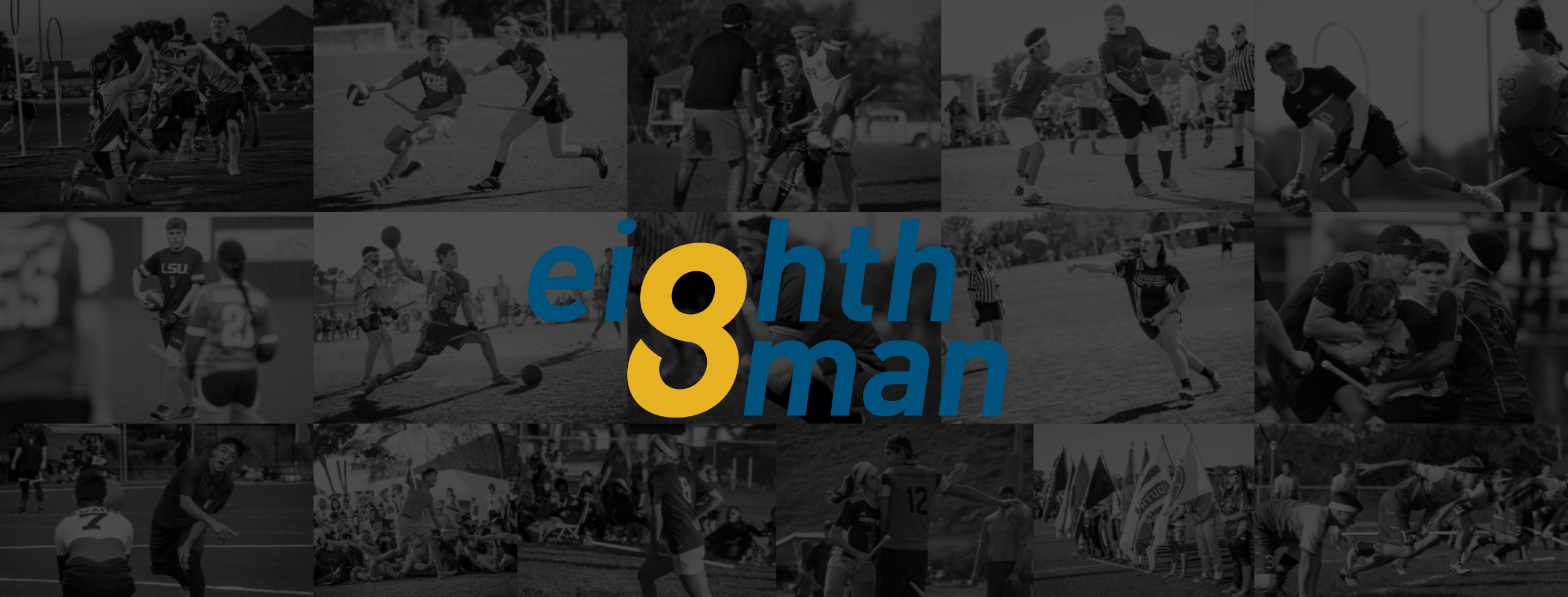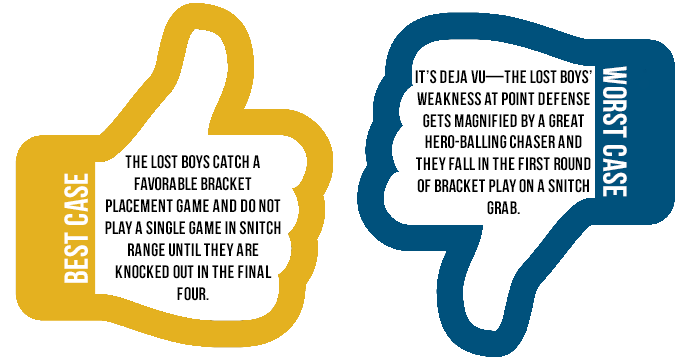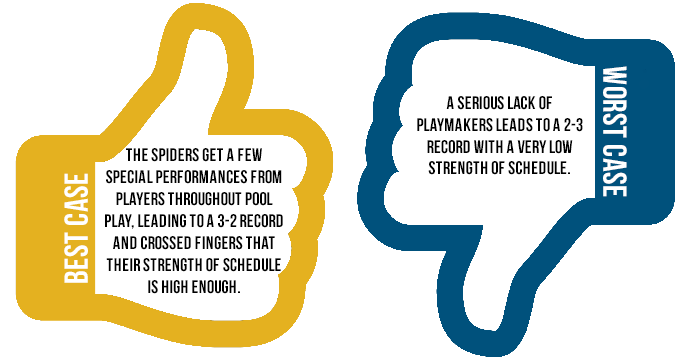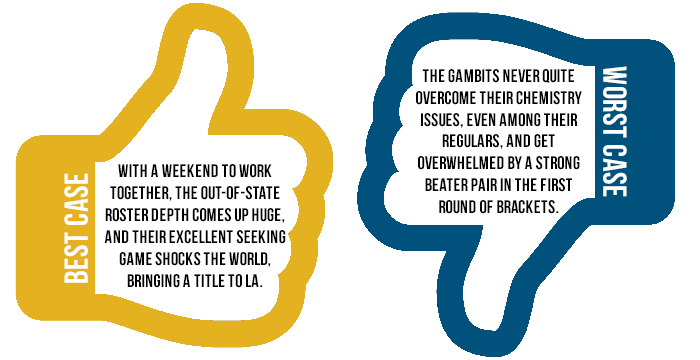Antwerp QC, Much of Belgian Core, Leaves Competitive Quidditch
Rock Hill Roll Call is your in-depth guide to the 80 teams that will compete for the title of World Cup 8 Champion. We’ve reached out to writers and analysts all over the country to bring you the lineups, strategies, focal points and aspirations of each and every attending team. Whether you are looking for a leg up on the competition or just want a detailed preview of the sport’s main event, this is the place for you.
 By Kevin Oelze
By Kevin Oelze
When the Lost Boys Quidditch Club is playing well, the team’s beaters completely control the pitch—whether it’s with a two-male beater set of any of its extremely talented male beaters—Michael Mohlman, Peter Lee and Chris Seto—or the latter two combined with the veteran presence of Maddy Wojdak. If the Lost Boys’ beaters can control the field, everything opens up for this Los Angeles-based community team: The beaters can sit back, pick off passes and shots and force their opponent’s offense to quickly give up the ball or lose possession after being beat.
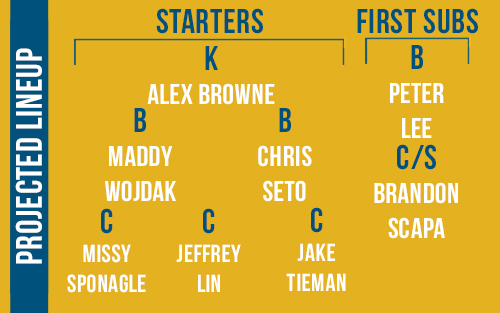 Offensively, this strategy lets keeper Alex Browne get going with a head of steam, which allows him to leap over bludgers and fire pinpoint passes to his many capable chasers. It also permits chaser Jake Tieman to act as a juggernaut and Browne’s favorite target, using his incredible size and bludger-blocking skills to power through the defenses that are already collapsing on Browne. When these two combine with the bludger game, it puts so much pressure on opposing defenses that often the rest of the Lost Boys’ chasers are simply left alone, which is never a winning formula with Missy Sponagle on the field.
Offensively, this strategy lets keeper Alex Browne get going with a head of steam, which allows him to leap over bludgers and fire pinpoint passes to his many capable chasers. It also permits chaser Jake Tieman to act as a juggernaut and Browne’s favorite target, using his incredible size and bludger-blocking skills to power through the defenses that are already collapsing on Browne. When these two combine with the bludger game, it puts so much pressure on opposing defenses that often the rest of the Lost Boys’ chasers are simply left alone, which is never a winning formula with Missy Sponagle on the field.
However, this team is much more than its beaters and male chasers. From top to bottom, the Lost Boys have athletes who play smart. Ultimately, if you succumb to the pressure their beaters create, you have probably already lost the game, because this team is too good and too smart to let you get away with playing passively.
 By Anonymous
By Anonymous
The Lost Boys have lost two games this year—a short-handed match against the Santa Barbara Blacktips and the West Regional Championship final against the LA Gambits. In both games, the opposing beaters sought to neutralize the aggression of Lee and Seto.
If you can negate the effect of the team’s beater strategy and turn the game around with more emphasis on the chasers, the Lost Boys can be beaten, particularly by taking advantage of their relative weakness in the seeking department compared to other elite teams.
Browne has good range covering passes, but as he is relatively short for a starting keeper at roughly 6 feet, he can be shot over on the tallest hoop. More importantly, none of the Lost Boys’ chasers are truly spectacular tacklers, which gives fast, physical teams the opportunity to make drives against them. Browne is extremely dangerous when he gains momentum, so the best way to contain him is to engage him or use bludgers to thwart him before he can build up his speed. He loves to jump over bludgers, so either aim high or use a pump fake to get him off his feet so he can be easily dispatched. If you can tire out Browne and force him to sub out, the drop off behind him is relatively large—although the team was using new pickup Griffin Conlogue as a backup keeper at regionals. Contain Browne and the beaters and you can beat the Lost Boys. Still, neither is an easy task.
By Max Miceli
University of Richmond is one of those teams that does almost everything well—it just doesn’t do anything spectacularly.
This team has few weak links in its starting lineup and has enough depth to consistently keep it close to the top in the Mid-Atlantic. The Spiders have just the requisite role players; however, they are missing something important: a star.
That’s right. Much like Bonnie Tyler, Richmond needs a hero.
If Richmond is going to make a deep run at World Cup 8, it needs to find that person other teams cannot account for without serious scouting. The team needs a player who instills fear in the hearts of opponents. It doesn’t matter which position this individual plays; what matters is they are the total package. This person could be a beater with a cannon arm, stellar accuracy and excellent positioning or a chaser who can tackle anything, score from anywhere and dish an accurate pass to anyone.
This hero could likely be newly-crowned captain Katie Rothert, a strong and typically conservative beater with the potential to shine if she can step up and make those more aggressive plays. But it could also be keeper Jeremy Day, a decent distributer and driver who could be a real offensive force if he didn’t play so recklessly. It could come from just about anywhere on the team’s starting lineup, and it doesn’t have to be the same person every game.
If Richmond wants to make an impression in Rock Hill, it needs a clutch player–it needs a star.
 By Anonymous
By Anonymous
Richmond as a whole doesn’t excel at any one thing. Instead, its roster is filled with above-average players top to bottom. The beaters are quicker and more agile than a typical team’s, and the chasers are just a bit more physical and athletic than what you see on the average pitch–this is what has allowed them to excel under the radar for years in the weak Mid-Atlantic region. The Spiders outplay those teams that aren’t as consistent or as experienced as they are and struggle against the better teams, hoping the conditions are just right for the upset.
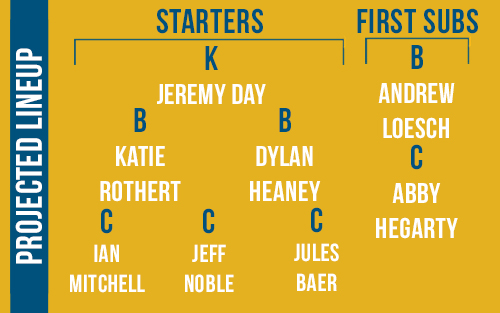 Really, the key to beating Richmond is flustering its beaters and driving it into the hole. The team’s defense is heavily reliant on bludgers, which is the most impressive part of its game. But when bludger control is removed from the equation, the defense struggles to lock onto one player. Richmond’s chasers can wrap but they can’t hit, so when a team has that one player who’s better than all of Richmond’s players, they can, with the right planning, score just about every time.
Really, the key to beating Richmond is flustering its beaters and driving it into the hole. The team’s defense is heavily reliant on bludgers, which is the most impressive part of its game. But when bludger control is removed from the equation, the defense struggles to lock onto one player. Richmond’s chasers can wrap but they can’t hit, so when a team has that one player who’s better than all of Richmond’s players, they can, with the right planning, score just about every time.
The Spiders’ offense features an above-average passing game. They understand ball movement and have players who can move off-ball, and what’s especially impressive is their lineup of female chasers–among the best on the East coast. Yet Richmond’s players are always too quick to take the wild mid-range shots, which maybe go in one out of 20 times. So if you can force this team’s shot by relaxing pressure up top, it will most likely always end in a missed opportunity.
Allow your star player to work through a chaser line that’s mediocre on defense, and try to force Richmond to make its favorite mistakes. Just make sure you play lockdown defense on the Spiders’ underestimated chasers.
By Dan Hanson
If the LA Gambits plan to make a deep run in Rock Hill, they will need to prove that their quaffle players can be consistently dominant.
The Gambits’ chemistry issues boil down to two things: the need to work in out-of-state players who do not practice regularly with the team and an inexplicable inability to move the ball among the three-headed monster that is Tony Rodriguez, Ren Bettendorf and Andrew Murray.
However, neither seemed to be an issue for the Gambits in the one game where it mattered most—the West Regional Championship final—a fantastic sign for the team going into Rock Hill. Bettendorf, Murray and Rodriguez are in the elite class of quaffle players, and the Gambits’ struggles leading right up to the final were hard to understand. Perhaps it is the experience they have accrued by playing the Lost Boys or the time their players have had to develop together over the course of the season. Either way, the Gambits never looked better in a game against an opponent in their own weight class.
The Gambits have created nice, low-pressure roles for their out-of-state players, making it easier for Rich Hatch (Nevada), Peter Reynebeau (Arkansas) and Edgar Pavlovsky (Utah) to excel on the team, and they will only get better with each game the Gambits play.
However, the cog that made their offense really turn in their biggest win of the year was none other than Caylen McDonald. McDonald stood out all year not because of her bright red hair but because of the sheer amount of space defenses give her. She is often left wide open behind the hoops, and for that reason she has converted a fair share of goals, though not nearly as many as she could have given the opportunity in her role. She stepped up when it mattered most though, positioning, passing and finishing better than she had all season. If she can perform in Rock Hill as she did in the West Regional final, the Gambits’ fearsome offense will become all the more threatening.
We still haven’t seen the ceiling of the Gambits’ offense, and they will hope to show it to us at World Cup. However, they have yet to prove they can be as good as they were at their regional on a consistent basis–there’s still the possibility this team could take a step back in a key game at World Cup that’ll cost it big time.
 By Anonymous
By Anonymous
The Gambits boast perhaps the best male quaffle depth in the United States outside of the state of Texas (and maybe even within), and this remains the reason why they are one of the best teams in the country.
The Gambits offense starts and ends with Rodriguez. He is the engine that keeps the offense running and elevates what would be a very good offense to a great one. As one of the best shooters in the game, Rodriguez stretches defenses and opposing beaters uncomfortably, opening up his passing game, which is one of the best when he’s willing to make a pass.
The team’s offense hasn’t utilized the catch and alley-oop game that Bettendorf starred in last season (and which continues to be a staple in the Santa Barbara Blacktips’ game), but the sheer talent and depth of the Gambits allows them to have a fair passing game. And when possible, they will run a one-and-a-half bludger offense to allow for a Rodriguez dunk.
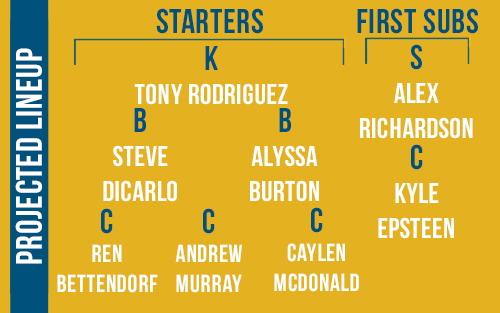 While the Gambits beating game has improved tremendously throughout the year, they do not make game-changing plays on a normal basis. This is fine because they don’t have to–their male beating rotation goes four deep, with a massively improved Steve DiCarlo manning the helm alongside female beater Alyssa Burton. Rodriguez continues to be probably the best shot-blocker in the country and, with their male quaffle depth, the Gambits will always have two male chasers who can wrap and hit opposing quaffle players.
While the Gambits beating game has improved tremendously throughout the year, they do not make game-changing plays on a normal basis. This is fine because they don’t have to–their male beating rotation goes four deep, with a massively improved Steve DiCarlo manning the helm alongside female beater Alyssa Burton. Rodriguez continues to be probably the best shot-blocker in the country and, with their male quaffle depth, the Gambits will always have two male chasers who can wrap and hit opposing quaffle players.
Finally, the seeking game is predicated on, again, this team’s male quaffle depth. With Alex Richardson, Pavlovsky and other physical male quaffle players at their disposal, the Gambits can throw multiple fresh seekers at the snitch to make a grab. In a snitch-range game, the chasers and seekers are good enough to hang around with any team in the country.
While World Cup takes place over just one weekend–a seemingly short amount of time to make conclusions about every region–it’s also a marathon, not a sprint. The Gambits are stocked with a plethora of above-average to excellent players in almost every position on their team, a key ingredient required for success this April in Rock Hill.
By Alex Wilson
While everyone on this team can hold their own, two of the University of Kansas Crimson Warhawks’ standout players are David Mora and John Palmgren. Each bring something very different to the table.
Mora has gained a lot of respect in the middle of the country as one of the region’s best snitches, and he uses his athleticism and speed to lead the Warhawks’ fast-break offense, scoring consistently when given the opportunity. His ability to streak down the sideline at top speed before cutting inside of his defender has led to a large portion of the Warhawks’ points this season. If opposing teams commit too many resources to Mora’s side of the field, he’ll demonstrate his skill and awareness with a toss to the far hoop for an easy dunk.
Palmgren is the polar opposite. On offense, he will follow beaters and inch up the field while they get in position. When one or both defensive beaters are taken care of, Palmgren will flip the switch and crash to the hoops with chasers on his sides for options. His height and strength allow him to either penetrate the defense and dunk or get a quick shot off through the middle hoops before he is beat. This worked well for the Warhawks this fall and will continue to get better as they work on timing. If this team can fix its defensive woes, it will be able to stay in range more often.
 By Alex Wilson
By Alex Wilson
The Warhawks are one of the older and more experienced B-teams in the country and just qualified for World Cup for the second year in a row. Having a skilled, top team to learn from and practice with is always a benefit, but the Crimson Warhawks have also carved out their own play style and identity apart from their blue counterparts.
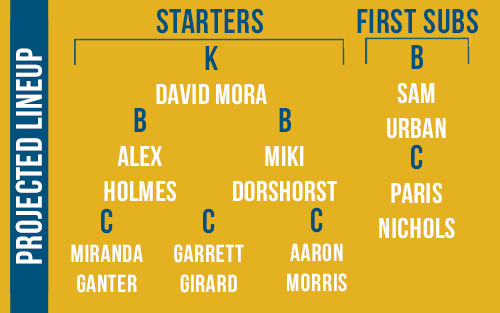 Lead by captain Mora, the Warhawks are a team that thrives on chemistry and well rehearsed formations to eliminate confusion on the field. They communicate extremely well on the pitch, consistently talking on offense and defense to make sure no one is left uncovered and controlling the pace so that they can be the ones to dictate the next move.
Lead by captain Mora, the Warhawks are a team that thrives on chemistry and well rehearsed formations to eliminate confusion on the field. They communicate extremely well on the pitch, consistently talking on offense and defense to make sure no one is left uncovered and controlling the pace so that they can be the ones to dictate the next move.
The Warhawks will vary between running slow and fast offenses, depending on what the opposing defense is giving them, and the whole team will be jump on board very quickly, leading to problems for opposing teams that can’t shift at their pace. They play to their strength and use teamwork to combat the fact that they do not get to pull the top athletes from their school, allowing them to stay competitive in middle-tier games while being able to comfortably win matches over weaker teams. With none of the superstar athletes from their university, the Warhawks are able to field a layer of depth where there is not a drastic drop off in player talent, giving them the ability to outlast smaller-rostered opponents.
Graphics and photo illustration by Amanda Dallas. Original photos by Nicole Harrig (top) and Matt Dwyer (bottom).
Archives by Month:
- May 2023
- April 2023
- April 2022
- January 2021
- October 2020
- September 2020
- July 2020
- May 2020
- April 2020
- March 2020
- February 2020
- January 2020
- December 2019
- November 2019
- October 2019
- August 2019
- April 2019
- March 2019
- February 2019
- January 2019
- November 2018
- October 2018
- September 2018
- August 2018
- July 2018
- June 2018
- April 2018
- March 2018
- February 2018
- January 2018
- November 2017
- October 2017
- July 2017
- June 2017
- May 2017
- April 2017
- March 2017
- February 2017
- January 2017
- December 2016
- November 2016
- October 2016
- September 2016
- August 2016
- July 2016
- June 2016
- May 2016
- April 2016
- March 2016
- February 2016
- January 2016
- December 2015
- November 2015
- October 2015
- September 2015
- August 2015
- July 2015
- June 2015
- May 2015
- April 2015
- March 2015
- February 2015
- January 2015
- December 2014
- November 2014
- October 2014
- September 2014
- August 2014
- July 2014
- May 2014
- April 2014
- March 2014
- February 2014
- January 2014
- November 2013
- October 2013
- September 2013
- August 2013
- July 2013
- June 2013
- May 2013
- April 2013
- March 2013
- February 2013
- January 2013
- December 2012
- November 2012
- October 2012
Archives by Subject:
- Categories
- Awards
- College/Community Split
- Column
- Community Teams
- Countdown to Columbia
- DIY
- Drills
- Elo Rankings
- Fantasy Fantasy Tournaments
- Game & Tournament Reports
- General
- History Of
- International
- IQA World Cup
- Major League Quidditch
- March Madness
- Matches of the Decade
- Monday Water Cooler
- News
- Positional Strategy
- Press Release
- Profiles
- Quidditch Australia
- Rankings Wrap-Up
- Referees
- Rock Hill Roll Call
- Rules and Policy
- Statistic
- Strategy
- Team Management
- Team USA
- The Pitch
- The Quidditch Lens
- Top 10 College
- Top 10 Community
- Top 20
- Uncategorized
- US Quarantine Cup
- US Quidditch Cup
